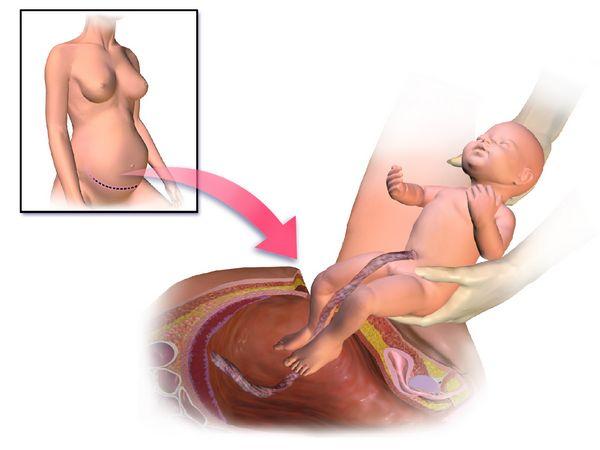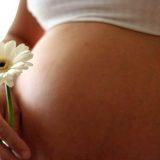Caesarean section and its implications

Caesarean section – a very common method of delivery in modern obstetrics. Its effects, in general, it is easier than in the old days. Yet they must be seriously weighed.
Cesarean section
Caesarean section – a surgical delivery, abdominal surgery. Child removed through abdominal incision uterus. Initially, cesarean section was a last resort when the complete inability of the mother to give birth with no hope of saving her life or after her death. Modern maternity use cesarean section in 12-27% of cases of all births. Although the World Health Organization recommends a threshold of 10-15%. Cesarean section may be conducted or planned in extra labor.
Indications for elective caesarean section:
- large fruit – more than 4 kg;
- abruptio placentae;
- transverse position of the fetus;
- small for gestational;
- narrow pelvis;
- deformation of the bones of the pelvis;
- divergence of the pubic bone;
- severe preeclampsia;
- malformations of the vagina, uterus;
- diseases of the nervous system;
- diseases of the cardiovascular system;
- serious eye problems, vision;
- uterine fibroids;
- placenta previa;
- exacerbation of genital herpes;
- oncology;
- perineal rupture in previous births;
- failure of the uterine scar after cesarean section and others.
Indications for an emergency caesarean section during labor:
- weakness of labor;
- discoordination labor;
- Clinical narrow pelvis – a big difference between the pelvis and the mothers of the fetal head;
- acute fetal hypoxia;
- low or detachment of placenta;
- incorrect insertion of the fetal head;
- loss of the umbilical cord loops;
- lack of effect of induction of labor;
- premature rupture of membranes, and others.
The average duration of the operation – 20-40 min. Even for caesarean section may be present in the presence of his father agreed with the doctor. Who is most commonly used epidural anesthesia instead of general anesthesia for caesarean section. Uses a filament which subsequently dissolve themselves. First allowed to rise at 6 hours after surgery. After 12 hours, or days transferred to the regular ward. Anesthesia is 2-3 days. For the first 1.5-2 hours on the stomach put an ice pack. Prescribers for uterine contractions and the normalization of the functioning of the gastrointestinal tract. Pursuing a course of antibiotics and administered saline. The first day allowed mineral water without gas. The second day – light broth, tea, oatmeal liquid broth. On the third day – nutrition for breast-feeding .On the 5th day carried ultrasound. Discharged on day 6-7. Housing is only allowed a shower. Baths – no earlier than 1.5 months.Fiznagruzki – 2 months. Sex usually resolved after 6 weeks, but better to visit a doctor. Planning for the next pregnancy are advised not earlier than 2 years.
Caesarean section: implications for mother
For the expectant mother a caesarean section may have the following consequences:
- Third of women after cesarean section are operative complications;
- infection of internal organs (uterus and nearby organs);
- risk of massive blood loss with the need of blood transfusion;
- unforeseen reactions to anesthesia (e.g., rapid pressure drop);
- weakening of the bowel;
- recovery, even with favorable postoperative course is slower than after vaginal delivery;
- isolation, small bleeding will last for 4-6 weeks after surgery;
- joint pain may persist for several weeks after surgery;
- pain can occur in the abdominal cavity, especially in lactating;
- more difficulties with breastfeeding, especially for planned caesarean section;
- bond between mother and child, their union are considered less severe than after vaginal delivery, especially after general anesthesia;
- following childbirth, with rare exceptions, it is also usually carried out by caesarean section;
- in rare cases, there is a need for additional operations;
- mortality in caesarean section increased by 4 times.
Caesarean section: implications for child
For the child, a caesarean section may also have negative consequences:
- Delivery by elective caesarean section can be called premature, because usually scheduled for 37 or 38 weeks – the baby is born prematurely a few;
- lack of natural run internal systems of life;
- poor performance on the Apgar score (due to anesthesia mother);
- perinatal mortality Caesarea 6 times higher than natural births;
- 29% of newborn Caesar have different diseases (infectious diseases, jaundice, respiratory tract pathology, metabolic disorders, stress);
- elective caesarean section increases the risk of asthma in the child by 40%, and an emergency cesarean section – 60%;
- respiratory disorders (transient tachypnea) to Caesar found on 7.2% more likely than those who were born in a natural birth (the first few days you may need an incubator);
- slight chance of traumatization;
- Disturbances of basic perinatal matrices child, especially with the planned caesarean section (not formed an active response to stress, struggle, laid wait outside help, there is no stamp of unity with the mother in these situations, there will be difficulties in separating from their parents in the future);
- development of children Caesar usually slower than those who were born in a natural birth;
- appearance of stillbirth is increased 2-fold with repeated cesarean section.
Some moms and many doctors, unfortunately, consider cesarean section more simple generic process. Some materials can even find calls to do a cesarean section. But sometimes it can significantly complicate the life of the expectant mother and the unborn child are almost always. Natural to you the conclusions and healthy delivery!
Want to learn more about caesarean section – read the book of French obstetrician Michel Auden “Caesarean section – a safe exit or threat to the future?”.













